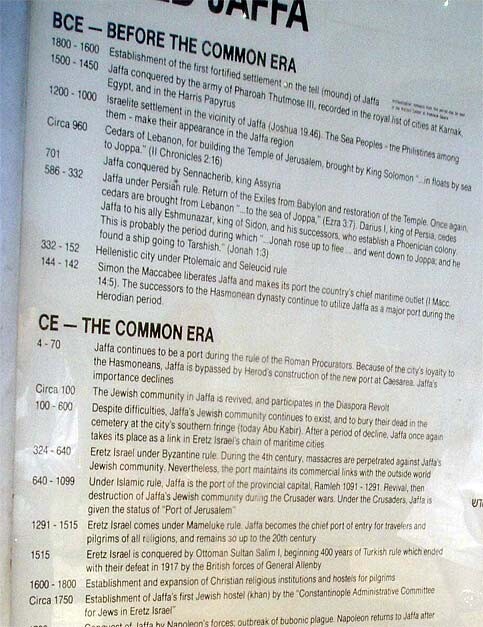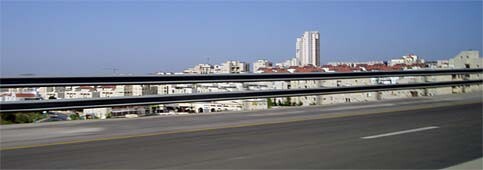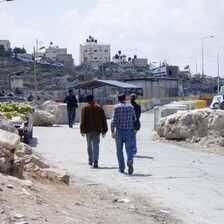
Jewish version of Yafa’s history, ‘abridged’ to gloss over non-Jewish events. Note how the 1000 years before the arrival of the Israelites are glossed over and shortened, and how all the other events relate to Jewish history, despite the majority of Jaffa’s residents throughout history being non-Jewish! No mention of the 100,000 Palestinians expelled in 1948, my own parents included.
Having seen the latest developments first-hand on this trip, it dawned on me that what’s going on over there is a full-blown genocide. A genocide in slow motion, perhaps, but a genocide nevertheless. When Sharon’s wall is completed, several million Palestinians will be completely surrounded by it, separated from the world and separated from each other. Their land and water sources will be on the Israeli side of the wall. Their only means of survival are on the other side, available only upon the approval of the Israeli military gatekeepers. This is indeed a genocide, subsidized in large part by Mr. US Taxpayer, ironically including myself.
The hurdles Israel imposes upon simple necessities for daily life are obviously meant to make people leave, and not come back. Ethnic cleansing for lack of a better word. Yet even as most Palestinians stay there, they are not to be seen. The West Bank has been transformed into a major Israeli playground, with little traces of Arab life within sight. An enormous network of new roads cut through the mountains, interconnecting massive Israeli colonies (so-called “settlements”). The old roads connecting Arab villages and cities were simply blocked off and left to rot. Arabs wishing to travel from one part of the West Bank to another need to follow narrow remote roads, and often get out of the car and walk over bare hills, risking getting shot at by Israeli “settlers” who hunt Arabs for sport.
A visitor driving on the new Israeli roads will see no signs of Arab life - just Jewish “neighborhoods”, as the Israelis fondly call their illegal and oppressive colonies, built to surround Arab cities on lands illegally expropriated from Arab farmers. Even the signs are all in Hebrew and English, with the place names transformed to sound like Hebrew. For instance, instead of the historic villages of Upper Beit ‘Ur and Lower Beit ‘Ur, the same “Upper and Lower Beth Horon” mentioned in the Book of Joshua as existing before Joshua’s invasion of Canaan, now you find a single large Jewish colony simply called “Beth Horon” built near its Arab namesakes. While the Arab villages still exist, they are conveniently out of sight from the new bypass road cutting deep through the mountain.
Names or the perceptions of them are critical to this conflict, it seems. Jerusalem, for instance, has for long been known to the Arabs as “al-Quds” - the Holy City. Since Israel took control of the city, they have been trying to impose the Arabized Hebrew name “Orashalim” on the city, e.g. in weather reports. As a child, I recall the road signs for Jerusalem were rather simple: “Yerushalayim” in Hebrew, “al-Quds” in Arabic, and “Jerusalem” in English. Later, when visiting back around 1993, I noticed the signs for Jerusalem had “Orashalim al-Quds” in Arabic, instead of the mere “al-Quds”. Today, on a road sign near the Arab city of Nazareth, I read the obituary: “Orashalim (al-Quds)” with al-Quds in parenthesis and in finer print. That leads me to wonder: “What next?” Plain “Orashalim”?
Of course this colony and road construction craze has resulted in an enormous impact on the environment, as arable land and water sources get depleted, and scenic mountains and landscape get torn inside out. There is hardly a hilltop on the West Bank today where one can stand without seeing barbed wire or an 8-meter high wall. The 4.5 million Palestinian residents of the West Bank, Gaza, and Israel are all but invisible. I found it very quiet in Ramallah. Though Palestinians there are not happy with the situation, it is difficult for them to even peacefully protest when their oppressor is conveniently shielded from them by several layers of wall. It is very easy to control a captive population, with a captive economy.
The situation inside Israel proper is even worse. I cannot even dream about ever returning to my ancestral homeland near Yafa and Ramleh. Nowadays I have to plead just to get a permit to see those cities. I am not even allowed to stay overnight, my permit explicitly stating “5 AM - 10 PM”, with some checkpoints effectively closing as early as 6 PM. Driving through Palestinian land occupied in 1948, one finds extremely little traces that the area was ever inhabited by Arabs. Apparently, the massive destruction campaign Israel undertook after 1948 paid well. If I’m careful and attentive, I might see a partially destroyed Arab building here, or a cactus patch from an Arab farm there, but most of the 418 villages Israel demolished to the ground betray no trace.
Crossing the “green line” from the West Bank to Israel, one is immediately transported from the 4th world to the 1st world. Israel presents itself today as a big megalopolis where speculators enjoy turning a buck from urban sprawl, while city centers (usually where Israeli Arabs live) are left to rot. Gone are the large swaths of orange groves between Ramleh and Yafa that existed as recently as 1990. Instead the Israelis welcome Big Mac and strip malls and big boxes. Israel itself is now populated mostly by Russians. Whether in Haifa or Jerusalem, more Russian is heard on the street than either Hebrew or Arabic, and Russian is now the official language on street signs in many places. I wondered why should some Russian of Slavic origin (whose ancestors perhaps recently converted to Judaism and who has absolutely no connection to the land whatsoever) have more access to my ancestral homeland than myself. By what right? Because God said so?
We saw the same tendency back at the airport. Droves of people from all over the world were welcomed into Israel: Europeans, Americans, Argentineans, Ethiopians, Chinese. All passed easily through the border, except the few of us who actually originated from that land and ventured to go back, who were taken aside to that Arab room. There, we were ignored for hours, as if the airport attendants had more important things to do, as if they were telling us we were not welcome there.
I began having that feeling as early as 1993. It was my first major trip back after leaving for college in the middle of the first Intifada. Many things had changed, including a so-called “framework” agreement between the PLO and Israel. What struck me back then were the changes on the ground: the almost permanent closure of Jerusalem (a new step at that time), the massive building projects in the Israeli colonies in the West Bank, and the beginning of the massive road network linking those colonies and bypassing Arab towns. Riding on one of those roads (still legitimate at that time for a Palestinian), as we passed by Beth Horon, I noted a small sign in Arabic pointing to the twin villages of Beit ‘Ur. Once on the main road from Ramallah to the West, the Beit ‘Urs have become off the beaten track, to be reached from a side road off of the colonial road. I looked right and left, and instead of Beit ‘Ur’s familiar ancient domed village houses, I saw the red roofs of modern Beth Horon. Instead of Beit ‘Ur’s plowed fields surrounded by borders of cactus plants, I saw swaths of minefields surrounded by barbed wire protecting the new colony. This is the West Bank, right? Supposed to be the last Palestinian stronghold in the land of Palestine, no? I look for any sign that there is Arab life. Apart from that small Arabic sign for Beit ‘Ur, all the remaining signs were in English and Hebrew only, pointing out Biblical relics and Israeli colonies with Biblical-sounding names. Suddenly, I felt like a stranger in my own land, as if history was ripped open and engulfed the memory of my forefathers. Thousands of years disappeared in the void, as the 1990s became connected to Biblical times. Back home, I was gripped by a fear that a tourist visiting the “Holy Land” and not knowing much history would never guess that any Arabs existed on the land. Driving in the West Bank just 100s of meters away from millions of Palestinians, the ignorant tourist can happily entertain the illusion that Jews have continuously inhabited an unchanged land since the time of Jesus.

The Israeli colony of Modi’in, in the West Bank (April 12, 2004)
In today’s term, that frightening feeling of invisibility and alienation I sensed in 1993 was just a premonition of things to come. The rapidly expanding colonies I saw back then were mere embryos of the megalopolises that now hungrily jostle for every inch of that congested landscape. The red roofs of Beth Horon are now eclipsed by the skyscrapers of Modi’in, another brand new colony just down the road. The little sign pointing to Beit ‘Ur is now gone, the side road connecting the Beit ‘Urs with the colonial road is now completely blocked off, isolating those two villages from the world. The colonial road itself can no longer be directly accessed from Ramallah. Its one entrance from near the military camp by the village of Beitunia is now blocked off by a massive wall guarded by tanks. The only way for Palestinians to enter this road is to cross the first checkpoint to Jerusalem (which requires a permit), then ride a car with a yellow license plate, identifying one as “Israeli”.
Tourists traveling to the West Bank today have to actively seek Palestinians in order to meet any. With few exceptions, Israel is in control of most historic and tourist sites, even within the West Bank. Before leaving on this trip, my wife and I spent much time pouring over travel books trying to identify places of interest for her. I desired to show her as much as I can of my country. It turned out all this time was unnecessarily wasted. Most places of interest were out of reach for Palestinians, several roadblocks away or beyond the wall. I was very, very lucky in obtaining a permit to visit “Israel” and Jerusalem. Most people there are not that lucky - an entire generation of Palestinian children having grown up in Bethlehem and Ramallah, only 10 min. away from Jerusalem, but having never set foot in that holy city. They live in one of the richest parts of the world, historically and culturally, yet are unable to taste this richness. By controlling the historic sites the Israelis also ensure that their version of history is what gets passed on to the tourists. The Israelis thus control the future, by ignoring or sidelining our past.
Today, I am really a stranger in my own country. I am discriminated against upon entering at the airport because the “city of birth” in my passport is “Jerusalem”, yet I have to apply for a permit to visit that same birthplace.
Dr. Saber Zaitoun is the pseudonym of a Palestinian-American in his thirties. Dr. Zaitoun grew up under Israeli occupation and first came to the USA during the first Intifada to finish his education. He is married, and currently teaches at a University on the East Coast. For more information about his visit to Palestine, please see www.triptopalestine.com.




